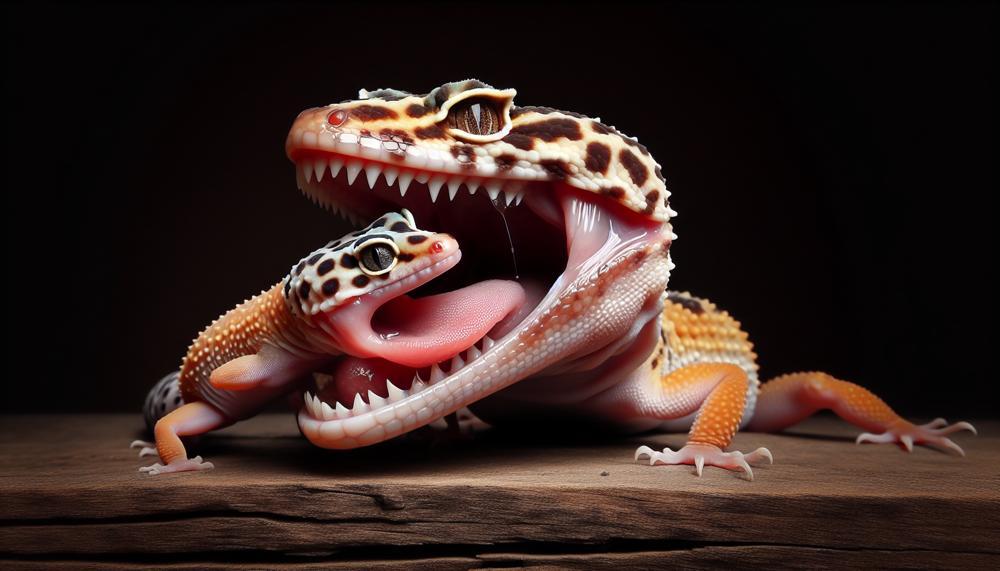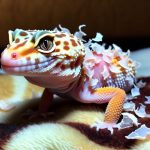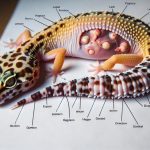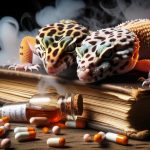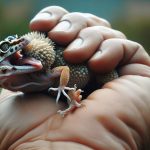There’s a silent threat lurking in the shadows – Mouth Rot. In this blog post, we’re diving deep into this condition, unraveling its mysteries to keep our scaly friends healthy and happy. Here’s what you need to know:
- What is Mouth Rot? Get the lowdown on this common yet often overlooked ailment.
- Signs to Watch For: Learn the telltale signs that your gecko might be in trouble.
- Prevention is Key: Discover how simple husbandry changes can make a big difference.
- Treatment Tactics: Find out what steps to take if your gecko falls victim to this condition.
Join us as we explore the ins and outs of Leopard Gecko Mouth Rot, arming you with the knowledge to safeguard your pet’s health and well-being.
Contents
What Is Leopard Gecko Mouth Rot?
Leopard Gecko Mouth Rot, known scientifically as infectious stomatitis or canker, is an affliction where harmful bacteria overrun the mouth. This ailment is not only painful for the gecko but also highly infectious and can spread to other reptiles.
Swift action is imperative as untreated mouth rot can spiral into grave complications, such as tooth loss, facial swelling, and even mortality.
Signs and Symptoms of Leopard Gecko Mouth Rot:
| Symptom | Details | Observation Tips |
| Excessive Drooling | Saliva more than usual, possibly thicker. | Check for dribbles or wetness around the mouth area. |
| Swelling | Visible puffiness in or around the mouth. | Notice any asymmetry or bulging in the head or jaw. |
| Redness | Unnatural pink or red tinges inside the mouth. | Gently open the mouth during a calm moment to inspect. |
| Bleeding or Pus | Blood or yellowish discharge in the oral cavity. | Look for discoloration or residue on the gecko or in the tank. |
| Behavioural Changes | Lethargy, loss of appetite, or reluctance to eat. | Monitor energy levels and eating habits closely. |
These symptoms may not all present at once and some may be subtler than others. When you spot any of these signs, it’s time to whisk your scaly mate to the vet pronto.
The vet’s expertise will be essential to diagnose the extent of the infection and prescribe the correct course of treatment. Fret not, with prompt and proper care, your gecko can be back to its sprightly self.
Health Complications It Can Cause
Leopard gecko mouth rot, or infectious stomatitis, isn’t something to take lightly. It’s a proper menace for your scaly mate, and if it’s not dealt with smartish, it can lead to a heap of trouble.
Below, I’ll lay out the potential health complications that this nasty infection can bring about.
| Complication | Description | Consequences |
|---|---|---|
| Dental Decay | Infected gums and mouth tissue can lead to tooth loss. | Difficulty eating, which can result in weight loss and malnutrition. |
| Bacterial Spread | The infection can spread from the mouth to other parts of the body. | Potential organ damage, which could be life-threatening. |
| Behavioral Changes | Pain and discomfort may cause changes in behavior. | Less interaction and possible aggression due to pain. |
| Secondary Infections | With the immune system compromised, other infections can take hold. | Further health issues, requiring additional treatment. |
| Vision Loss | If the infection spreads to the eyes, it could lead to impaired vision. | Challenges in navigating their environment, stress, and vulnerability. |
Leopard Gecko Mouth Rot Symptoms
Identifying mouth rot in your beloved leopard gecko promptly can forestall a heap of health woes.
Visual Clues and Behavioral Shifts
| Visual Symptom | Behavioral Symptom | What to Look For |
|---|---|---|
| Swelling | Lethargy | Puffy, inflamed gum tissue and a swollen jaw can indicate infection. |
| Redness | Loss of Appetite | A stark, angry red in the mouth, not your usual pink, points to trouble. |
| Pus Accumulation | Reluctance to Eat | Look for any off-white or yellowish discharge—it’s a sure-fire red flag. |
| Bleeding | Difficulty Catching Prey | If you spot blood where your gecko chomps, don’t dilly-dally. |
| Dental Decay | Weight Loss | Loose or missing teeth are a grim giveaway of the disease’s progression. |
Don’t Drag Your Feet
When your gecko starts drooling more than a teething tot or you clock any unusual gum and mouth antics, it’s not just odd; it’s a klaxon call for a vet visit.
If your scaly sidekick’s usually perky demeanour gives way to dawdling about, or they shun their chow like a fussy eater at a buffet, it’s high time for a professional’s peepers on the problem.
Cleanliness is Next to Gecko-liness
Keep their digs spick-and-span to ward off this gnarly infection. And remember, good grub isn’t just tasty; it’s their armour against ailments like mouth rot. Spot something amiss? Dash to the doc.
Bottom Line
If you catch your gecko looking like they’ve chewed on a chilli, with a gobby red gob or other ominous signs, hop to it and hightail them to a herp-wise healer.
The Cause of Mouth Rot in Leopard Geckos
Mouth rot, scientifically known as stomatitis, is a distressing ailment affecting leopard geckos, presenting as an inflammatory condition of the mouth.
This affliction stems from a variety of factors, often linked to suboptimal care. The table below encapsulates the principal causes:
| Cause | Description | Preventive Measures |
|---|---|---|
| Injuries | Scratches or bites from live feed or abrasive substrate. | Provide soft substrate and monitor feeding interactions. |
| Poor Nutrition | Lack of essential vitamins, especially vitamin A. | Ensure a balanced diet with vitamin supplements. |
| Incorrect Habitat Conditions | Temperature and humidity levels not within the ideal range. | Regularly check and adjust environmental conditions. |
| Unclean Enclosure | Bacterial build-up due to infrequent cleaning. | Clean the habitat regularly and replace substrate as needed. |
| Secondary Infections | Compromised immune systems from other health issues. | Address primary health concerns promptly. |
How To Treat It
To combat leopard gecko mouth rot, swift and precise treatment is paramount.
Effective Treatments
| Initial Home Care | Cleanse the oral cavity with a saline solution or reptile-safe antiseptic. |
| Veterinary Intervention | Administer prescribed antibiotics and possibly anti-inflammatory medication. |
| Supportive Care | Offer soft foods to ease pain during eating and ensure adequate hydration. |
Prevention Strategies
| Nutrition | Supply a diet rich in vitamins, particularly Vitamin A, to support immune health. |
| Habitat Maintenance | Keep the enclosure spotless and maintain proper humidity and temperature. |
| Regular Checks | Monitor your gecko for early signs of mouth rot and other ailments. |
| Quarantine New Arrivals | Isolate new geckos to prevent potential spread of infections. |
Symptoms like drooling, swelling, and behavioral shifts signal a trip to the vet is due.* Remember, nip mouth rot in the bud before it wreaks havoc. Keep their home in tip-top shape, dish out top-notch grub, and keep a keen eye on your scaly mate’s chompers.
Tips For Preventing Mouth Rot In The Future
Here’s a structured approach to maintaining a mouth rot-free environment for your leopard gecko:
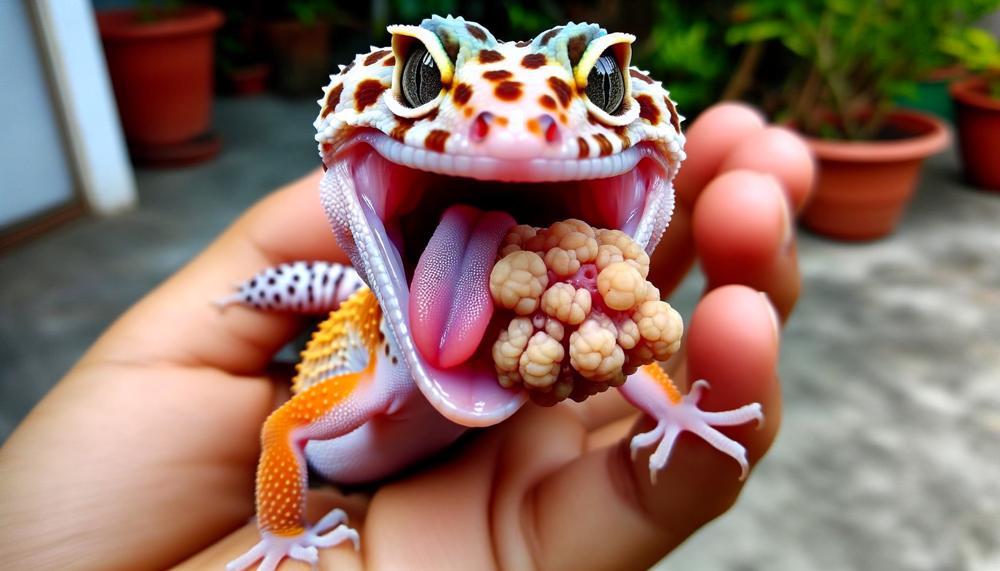
Habitat Hygiene
| Task | Recommendations |
| Cleanliness | Regularly clean and disinfect the enclosure to prevent bacterial growth. |
| Substrate | Choose an appropriate substrate that is easy to clean and non-irritating. |
| Humidity and Temperature | Maintain optimal levels to mimic their natural habitat and support their immune system. |
Nutrition and Supplements
| Aspect | Guidelines |
| Diet | Offer a varied diet rich in essential nutrients, including gut-loaded insects. |
| Supplements | Provide calcium and vitamin supplements to prevent nutritional deficiencies. |
Monitoring Health
| Action | Details |
| Observation | Keep an eye out for signs of mouth rot such as swelling, pus, or reluctance to eat. |
| Veterinary Care | Seek professional advice at the first sign of illness for timely intervention. |
Precautionary Measures
| Measure | Explanation |
| Live Food Safety | Ensure live food is safe and won’t harm your gecko’s mouth. |
| Quarantine | Isolate new or sick geckos to prevent the spread of infections. |
Regular Maintenance
| Practice | Importance |
| Clean Mouth Area | Use safe antiseptics to clean the gecko’s mouth gently as needed. |
| Enclosure Disinfection | Thoroughly disinfect the habitat if mouth rot has been present. |
Keep your gecko’s world spick-and-span, chock-full of the right grub and vitamins, and always be on the lookout for any signs of trouble. Quick action and a smidge of prevention go a long way in keeping mouth rot at bay. If you’re in a pickle, a vet’s sharp eye can spot the early signs and nip them in the bud.
When To Visit Your Veterinarian
Mouth rot, or infectious stomatitis, can be a blight on your leopard gecko’s well-being. Keep a sharp eye out for these symptoms, as they’re a signal to hustle over to your veterinarian:
| Sign | Details | Action |
| Drooling | Unusual dribbling may be the first clue | Time to raise the alarm and book a vet visit |
| Swelling | A puffy jaw is a sure sign of distress | Don’t dally; get to the vet posthaste |
| Redness | Look for inflamed tissue around the mouth | Red flags flying? Vet time. |
| Bleeding | Any blood around the gob is a bad sign | It’s a vet-bound issue, and pronto |
| Pus Accumulation | Yellowish discharge? It’s likely infection | Speed to the vet; your gecko needs you |
| Tooth Decay | Rotten teeth aren’t just a human worry | Get thee to a veterinarian quickly |
| Behavioral Changes | Less chow, more hide? Something’s up | Odd antics? A vet will suss it out |
If these signs are appearing, it’s not the moment for home remedies. Your scaly pal requires professional help to nip mouth rot in the bud. Don’t skimp on care; even a seemingly small symptom can herald bigger troubles.
Trusty vet care can turn the tables on mouth rot, with your vet likely to prescribe antibiotics or suggest a clean-up of the wee one’s oral cavity.
Husbandry is the Best Defence
A stitch in time saves nine, they say, and that’s doubly true in the case of leopard gecko care. A clean home, a diet chock-full of nutrients, and stable, comfy digs are your best bets against mouth rot. Keep things spick and span, and your gecko’s grin should stay as bright as a button.
Remember, noticing any dodgy symptoms in your gecko’s mouth? Don’t sit on your hands. Take a jaunt to the vet’s office.
Conclusion
In conclusion, these cherished reptiles are at serious danger for developing infected stomatitis, sometimes known as leopard gecko mouth rot. It is crucial to recognize the symptoms, which include excessive drooling, visible swelling, redness, pus, and behavioral abnormalities. In order to avoid serious health issues that might result in tooth decay, bacterial spread, behavioral abnormalities, secondary infections, and even eyesight loss, early identification and treatment are essential.
As we’ve seen, prevention is mostly dependent on good husbandry, which include supplying a healthy food, keeping the habitat clean, and making sure the right environmental conditions are there. Seek out veterinarian assistance right away if you notice any concerning signs. You can protect your scaly friend’s health and happiness by being vigilant.
Usually, a veterinarian will prescribe antibiotics and rinse the mouth with a saline solution as part of the treatment. Providing your gecko with supportive care, including soft food and making sure it stays well hydrated, can help it heal.
Never forget that early detection and prompt treatment are essential in the fight against mouth rot. You may contribute to your gecko’s long and healthy life by keeping him in a clean and well-maintained habitat and paying attention to his requirements.

